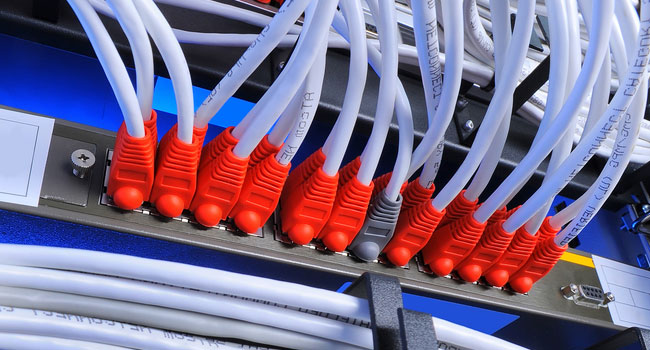
Bring on the Power
Understanding that PoE impacts network design
- By Steven Olen
- Mar 01, 2015
When selecting a PoE switch for an IP surveillance network,
system integrators should be aware that not all switches are
created equal. PoE switch manufacturers offer a variety of
different features that can impact functionality and pricing.
For example, port speeds may support 10/100, or Gigabit,
or perhaps a combination of both. Form factors can vary from compact/desktop
to rack-mountable. Power supplies may be external power bricks, or internal components.
More importantly, PoE power budgets will vary from switch to switch.
Understanding the power budget of a PoE switch, and how it impacts network
design, will help system integrators make better buying decisions and ensure the
right product gets used at the right price.
Background: PoE Standards
Standards-based PoE switches typically support either IEEE 802.3af or IEEE
802.3at. IEEE 802.3af—the original PoE standard ratified in 2003—provides up
to 15.4W of power at each PoE switch port. Accounting for voltage drop along the
cable, it ensures at least 12.95W of power is available at the IP camera, IP phone
or other PoE device.
IEEE 802.3 at—the newer standard ratified in 2009—is backwards compatible
with 802.3af, and supports higher power levels. At the PoE switch port, 802.3at
supports up to 30W of power, of which 25.5W are ensured to be available to the
PoE device.
When shopping for a PoE switch for an IP surveillance network, it’s important
to document the power requirements for each camera in the network, and plan
accordingly. These specs are typically available on the camera datasheets. Most
common indoor cameras will draw under 6 watts. For such cameras, a PoE switch
supporting 802.3af is normally sufficient. Some outdoor cameras may contain
heaters/blowers for temperature control. Other cameras may have PTZ motors.
Cameras in these categories may require additional power beyond what 802.3af
can support, and would therefore need a PoE switch that supports 802.3at.
PoE Power Budget
The power budget of a PoE switch is the total amount of PoE power that the
switch can provide to all the connected devices at the same time. The power can
be allocated across all PoE ports as needed. Port 1 may require 2W, port 2 may
require 10W, and port 3 may require 12W. As long as the switch has a budget of at
least 24W, all devices will function as intended.
Some PoE switches are designed with a PoE power budget sufficient to provide
“full” 802.3af power (15.4W), or full 802.3at power (30W), concurrently on all
ports. An 8-port switch supporting full 802.3af power, for example, would have a
power budget of 8 x 15.4W = 123W (approximately).
However it is important to remember that powered devices like IP cameras
will only draw as much power as they need. Why pay for excess power capacity in
a switch if it’s never going to be needed? A full power PoE switch will always be
more expensive than its counterpart with a smaller PoE power budget. If a full
power 8-port PoE switch was connected to a network of eight IP
cameras, with each camera drawing only 2W, for example, a switch with a power budget of 16W
would suffice. The 123W PoE switch would be over-designed and overly expensive.
Not only do larger PoE power budgets drive up costs, they also may present
thermal challenges. An 8-port PoE switch with 78W PoE budget will run cooler
than a similar 8-port switch with 123W budget. The 78W switch will likely not
need fans, whereas the 123W switch may.
Sometimes, a case can be made for deploying a full power PoE switch, in spite
of the additional costs. In surveillance networks for example, conditions and requirements
often change after initial installation.
Additional cameras may get added, or existing cameras may get swapped out.
Daytime-only cameras may get replaced with cameras that have integrated IR illumination.
Fixed dome cameras may get replaced with PTZ dome cameras. So
installing full power PoE switches on “day-one” gives the system integrator peace
of mind that his network is future-proof. Although he doesn’t need all that power
today, he may need it tomorrow.
Unmanaged versus Smart PoE Switches
A final consideration for a system integrator would be whether to deploy unmanaged
or smart PoE switches. An unmanaged PoE switch has no user configurable
options and no user interface, whereas a smart PoE switch will have an intuitive,
easy to navigate graphical user interface (GUI) that can be used for configuration
and monitoring of the network.
A smart switch will have a distinct advantage over an unmanaged switch when
it comes to monitoring the PoE power budget. With an unmanaged switch, the
network administrator has no visibility into how much PoE power is actually
being drawn from the switch. As new cameras are turned up, power demands on
the switch may eventually exceed its budget and the network administrator may
not be aware.
With a smart switch, the network administrator can easily monitor the real time
PoE power draw using the switch’s GUI.
System integrators have many important things to consider when setting up
a surveillance network, and PoE power budget should be one of them. Clearly
understanding the power requirements of all devices in the network will help with
high-quality network planning, and will ensure appropriate switches are used that
meet the project’s budget.
Smart PoE switches have an advantage over unmanaged PoE
switches with their ability to configure and monitor various
switching functions, including budgets.
This article originally appeared in the March 2015 issue of Security Today.